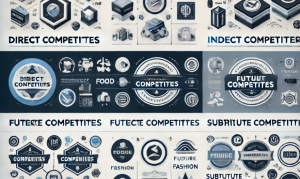In today’s business world, understanding your competition is no longer optional – it’s essential for survival and growth. Competitive analysis provides crucial insights that can shape your strategy, improve your products, and ultimately drive your success. This comprehensive guide will walk you through the fundamentals of competitive analysis, key techniques, and best practices to help you stay ahead in your industry.
Understanding the Competitive Landscape
Before diving into specific techniques, it’s crucial to understand what competitive analysis entails and why it matters.
Competitive analysis is the process of identifying and evaluating your competitors’ strengths and weaknesses about your own. This analysis helps you:
- Identify market opportunities
- Anticipate industry shifts
- Improve your products or services
- Refine your marketing strategies
- Make informed business decisions
To begin, you need to identify your competitors. These generally fall into three categories:
- Direct competitors: Businesses offering similar products or services to the same target market.
- Indirect competitors: Companies that offer different products but could satisfy the same customer needs.
- Potential competitors: Businesses that could enter your market in the future.
Core Competitive Analysis Techniques
Once you’ve identified your competitors, it’s time to analyze them using proven techniques. Here are some of the most effective methods:
SWOT Analysis
SWOT (Strengths, Weaknesses, Opportunities, Threats) analysis is a versatile tool that can be applied to both your business and your competitors. For each competitor, identify:
- Strengths: What do they do well? What unique resources do they have?
- Weaknesses: Where do they fall short? What could they improve?
- Opportunities: What market trends could they capitalize on?
- Threats: What external factors could harm their business?
Porter’s Five Forces
Developed by Michael Porter, this framework helps you understand the competitive forces in your industry:
- The threat of new entrants
- Bargaining power of suppliers
- Bargaining power of buyers
- Threat of substitute products or services
- Rivalry among existing competitors
Analyzing these forces for your industry can reveal opportunities and threats that might not be immediately apparent.
Benchmarking
Benchmarking involves comparing your business processes and performance metrics to industry best practices. This can include:
- Financial benchmarking (revenue, profit margins, etc.)
- Process benchmarking (efficiency, quality, etc.)
- Strategic benchmarking (business models, market positioning)
Gap Analysis
Gap analysis helps you identify the difference between your current performance and where you want to be. This technique can be applied to various aspects of your business, including:
- Product Features
- Market share
- Customer satisfaction
- Financial performance
Digital Footprint Analysis
In today’s digital age, analyzing your competitors’ online presence is crucial. This includes:
- Website analysis (traffic, user experience, content strategy)
- Social media presence (engagement, follower growth, content types)
- SEO performance (keyword rankings, backlink profile)
- Online advertising strategies (PPC campaigns, display ads)
Tools like SEMrush, Ahrefs, and SimilarWeb can provide valuable insights into your competitors’ digital strategies.
Leveraging Technology for Competitive Intelligence
The rise of big data and artificial intelligence has revolutionized competitive analysis. Here are some ways technology is enhancing this process:
AI-Powered Competitor Monitoring
AI algorithms can continuously monitor competitor websites, social media, and news sources, alerting you to significant changes or announcements in real time.
Predictive Analytics
By analyzing historical data and market trends, predictive analytics can forecast competitor actions and industry shifts, allowing you to proactively adjust your strategies.
Sentiment Analysis
Natural language processing techniques can analyze customer reviews, social media comments, and other text data to gauge public sentiment toward your competitors’ products or brands.
Automated Reporting
Many competitive intelligence tools now offer automated reporting features, saving time and ensuring you always have up-to-date information at your fingertips.
Best Practices for Effective Competitive Analysis
To get the most out of your competitive analysis efforts, consider these best practices:
Make it an Ongoing Process
Competitive analysis should not be a one-time event. Set up systems to continuously monitor your competitors and update your analysis regularly.
Focus on Actionable Insights
Don’t just collect data for the sake of it. Always ask, “How can this information inform our decision-making?”
Look Beyond Direct Competitors
Pay attention to indirect competitors and potential disruptors in your industry. Sometimes the biggest threats come from unexpected places.
Involve Multiple Departments
Competitive analysis shouldn’t be siloed in the marketing department. Involve sales, product development, and other teams to get a well-rounded perspective.
Use a Mix of Quantitative and Qualitative Data
While numbers are important, don’t neglect qualitative insights from customer feedback, expert opinions, and industry trends.
Stay Ethical
Always conduct your competitive analysis through legal and ethical means. Avoid any tactics that could be considered corporate espionage or unfair business practices.
Case Study: How Netflix Outmaneuvered Blockbuster
One of the most famous examples of effective competitive analysis is Netflix’s triumph over Blockbuster. In the early 2000s, Netflix recognized several key weaknesses in Blockbuster’s business model:
- Reliance on physical stores
- Late fees as a significant revenue source
- Limited selection in each store
Netflix capitalized on these weaknesses by:
- Offering a mail-order DVD rental service with no late fees
- Providing a much larger selection of titles
- Investing early in streaming technology
By the time Blockbuster tried to adapt, it was too late. Netflix’s thorough understanding of its competitor’s weaknesses and the changing market landscape allowed it to disrupt the entire industry.
Conclusion: Turning Insights into Action
Competitive analysis is a powerful tool, but its true value lies in how you use the insights you gain. As you implement these techniques, remember that the goal is not just to react to your competitors, but to innovate and lead in your industry.
Regular, thorough competitive analysis can help you:
- Identify and capitalize on market gaps
- Improve your products and services
- Refine your unique value proposition
- Anticipate and prepare for industry changes
- Make more informed strategic decisions
By mastering these competitive analysis techniques, you’ll be better equipped to navigate the challenges of your industry and drive your business toward sustainable success.
Remember, while tools and techniques are important, they’re no substitute for strategic thinking and decisive action. The most successful companies use competitive analysis as a springboard for innovation, not just imitation.
As you embark on your competitive analysis journey, consider consulting with business plan experts who can provide additional insights and help you translate your analysis into a robust business strategy. With the right approach, competitive analysis can be your secret weapon for business growth and market leadership.








